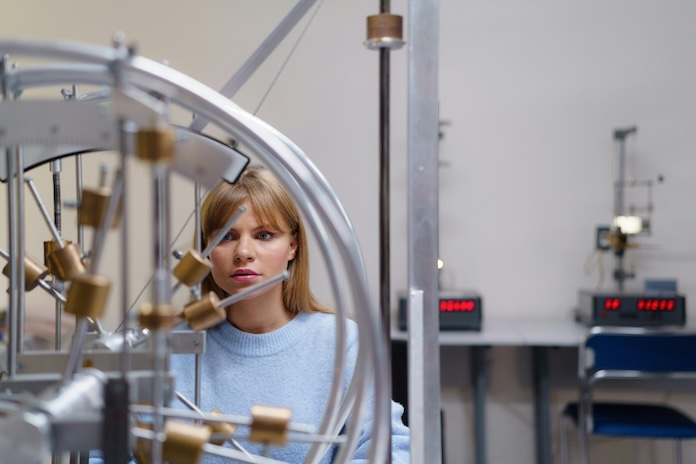In February, the College Board announced physics course and exam revisions, which will take effect with the 2024-25 school year (May 2025 AP Exams).
As the AP program continues to expand and evolve, so do the opportunities for students to delve more deeply into the study of physics through four different AP Physics courses: AP Physics 1, AP Physics 2, AP Physics C: Mechanics and AP Physics C: Electricity and Magnetism. As high school students make decisions about course selection, they might be wondering how to distinguish between these classes, and which ones are most important for college admissions.
To help make sense of these options, we’ve enlisted the expertise of our seasoned physics tutor, Collin, to answer your frequently asked questions about these different physics courses, the associated exams, and how to navigate AP preparation.
AP PHYSICS ROADMAP
What are the key differences between the four Physics AP offerings? How should a student decide which course to take based on their interests and career goals?
AP Physics is divided up by mathematical proficiency and subject matter. AP Physics 1 and 2 are geared more towards students with a strong Algebra background but who have not (or choose not) to explore Calculus I and II. Physics 1 focuses mostly on Mechanics, whereas Physics 2 is a broader overview of fluids, thermodynamics, electricity and magnetism, and optics. AP Physics C: Mechanics and AP Physics C: Electricity and Magnetism take the core concepts from Physics 1, and the E&M from Physics 2, but allow students to solve more complex problems with Calculus equations.
I recommend students take AP Physics C: Mechanics and AP Physics C: Electricity and Magnetism sequentially if they want to pursue a STEM field in college and beyond. Scoring a 5 on both of these exams can eliminate an entire year of Physics course requirements from a student’s college curriculum, freeing up space for other topics of interest or higher-level physics classes. If a student is unsure of what they’d like to pursue in college, or is leaning away from a STEM-intensive major, I recommend studying both AP Physics 1 and 2 to gain a broader understanding of the field.

AP Exam Tutoring
Our tutors offer customized tutoring designed to fit the needs of each student.
AP PHYSICS 1 AND 2: CONTENT FOCUS
Can you provide an overview of the major topics covered in AP Physics 1 and AP Physics 2? How does the content in each course contribute to a student’s understanding of fundamental physics concepts?
AP Physics 1 focuses almost entirely on Mechanics. Topics covered include Energy and Momentum, Statics and Dynamics, Simple Harmonic Motion, and Torque and Rotational Motion. AP Physics 2, conversely, is broader and gives the student a sample of various non-mechanics topics including Circuits, Electric Fields, Optics, Molecular Physics, and Fluids. Overall, the content covered in AP Physics 1 and AP Physics 2 courses equips students with the knowledge, skills, and mindset necessary to understand and appreciate the fundamental principles of physics and their applications in the world around them. By engaging in hands-on activities, problem-solving exercises, and critical thinking tasks, students develop a robust foundation in physics that prepares them for further academic and professional pursuits.
AP PHYSICS C: MECHANICS AND ELECTRICITY/MAGNETISM
For students interested in AP Physics C, what are the distinct features of the Mechanics and Electricity/Magnetism courses? How should a student determine if they are better suited for one over the other, or is taking both is advisable?
Both Mechanics and E&M at the AP Physics C level require students to at least be enrolled in Calculus BC concurrently. The mathematics involved is a bit more complex than what would be seen in Physics I and II, so I always recommend a student to have already learned Calculus or be learning it side-by-side. Mechanics at the C-level takes the concepts from AP Physics I, but uses derivatives and integrals instead of linear slopes and areas to solve complex problems. Physics C Electricity and Magnetism does the same, but focuses only on these subsets of Physics II while eliminating any content on optics, thermodynamics, and fluids.
I always advise students to take both Physics C Mechanics and Physics C Electricity and Magnetism. Seeing as students at this level are already preparing themselves for a STEM-based field and possibly career, taking both classes sequentially will help narrow down their interest in Math and Science to a specific major or concentration. Mechanics and Electricity and Magnetism are very different concepts that require different ways of approaching problems. While it’s very possible to succeed at both, every student I’ve worked with has formed a preference for one vs. the other which can help narrow down career choices in the future.
STUDY STRATEGIES FOR AP PHYSICS
What study techniques do you recommend for mastering the content of AP Physics exams? Are there specific approaches that work well for different courses, such as problem-solving strategies or conceptual understanding emphasis?
Studying for these exams usually requires a three-pronged approach: focus on conceptual understanding, focus on problem-solving, and focus on timing. The timing piece of the equation is often overlooked when teaching this course, but it is arguably one of the most important when it comes time to take the AP Physics examination. Regardless of the AP Physics class chosen, I always recommend students start with a high-level understanding of the concepts taught. From there, a few problems should be solved that correlate with the topics previously learned. Before going any further, I advise that students go back to the conceptual topics to see if any new discoveries have been made from trying a few problems. I’ve found that most students understand the bulk of the material at first, but solving problems and going back to the concepts afterwards fully instills the remaining 10% of content that might have caused some uncertainty. Once these two pillars (understanding and problem solving) have been mastered, I lastly focus on time management to ensure that problems can be solved within the allotted window given on the exam.

Executive Functioning & ADHD Support
Guiding students in grades 4-12 to their full potential.
PREPARING FOR AP PHYSICS EXAMS
Given the unique nature of each AP Physics exam, what advice do you have for students preparing for the exams, especially in terms of time management, practice tests, and balancing theoretical knowledge with practical problem-solving skills?
Balancing conceptual understanding with problem solving is really the key here, as they reinforce each other when done in tandem. In my opinion, it is never enough for a student to only solve problems or only understand the concepts. Hopping back and forth from concepts to problems allows students to absorb more and more of the content with each rotation. I’ve found that many students increase their conceptual understanding during the problem-solving process, and likewise think of novel ways to solve problems while re-learning concepts. As far as the specific problems go, I always recommend students use the sample College Board AP Practice Problems as a guide. While problem sets from other sources or textbooks are part of all courses and integral to a student’s learning, AP Practice Problems really prepare students on what to expect on the exam. Once a student feels strongly that they understand the concepts, can solve complex problems, and solve the AP Sample Questions, I then recommend adding in the time management piece of the equation to ensure that the problem-solving process followed can be done in the allotted time available for the exam.

Meet Top Tier Admissions Tutor, Collin
Collin grew up in Chicago, Illinois and has always had a strong passion for Math and Physics. His senior year of high school he received 5s on the BC Calculus AP Exam and both Physics C AP Exams, and was Valedictorian of his high school (rank 1/832).
Collin went on to pursue an Electrical Engineering degree at Washington University in St. Louis, but was looking for even more Math and Physics based courses so added two minors to his curriculum: Physics and Nanoscale Science and Technology. It was during his undergraduate years that Collin also developed a passion for tutoring other students. In total, Collin has tutored high-school and university students 500+ hours over 10+ years in both a 1:1 capacity and a group setting (Head Laboratory TA for Circuits I and II).
After his bachelors, Collin completed graduate courses in Electrical Engineering at UC Berkeley and now works professionally as an Electrical Engineer. He currently designs automated testing systems for Life Fitness, where his products are used 60+ hours a week to validate manufactured cardio equipment.
Collin believes analogies are the foundation on which a strong conceptual understanding is built. He’s helped STEM and non-STEM students alike succeed in Math and Physics through his ability to explain the same problem through multiple lenses. At the end of the day, he believes it is how the problems are presented that convey understanding. It is this unique approach that allows him to assist students of all academic backgrounds and preferred methods of teaching.
Follow us on Instagram @toptieradmissions for more tips and the latest admissions news!
- Application Boot Camp®: Celebrating 20 Years of Success - April 25, 2024
- Get to Know College Admissions Expert, Bryan Tomlinson - April 24, 2024
- Breaking News: Cornell Reinstates Standardized Testing - April 23, 2024

